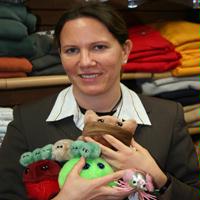For Wilson, science is an art
Anyone who thinks that art and science don’t mix hasn’t met Stephanie Wilson. Wilson, a graduate student in Biological Sciences with Professor Deborah Steinberg, has been combining the two fields since she was in high school. Her creations, which include plankton-themed drawings, pottery, and lino printing, have spiced up life in Steinberg’s Zooplankton Ecology lab since Wilson began her studies at VIMS in 2003.
Challenging the stereotypes of both the starving artist and the poor grad student, Wilson artwork has even helped her earn a small profit. She designed a new aquatic line for Giantmicrobes, Inc., a toy company that creates stuffed likenesses of common microorganisms, and used her modest earnings to pay for parking and health insurance fees. Wilson’s designs are for red tide (Alexandrium tamarense), algae (Anabaena), sea sparkle (Noctiluca), pond scum (Biddulphia), and krill (Euphausia superba). She also wrote a placard that gives for each animal sold a brief scientific description of the animal’s biology and ecology.
 Wilson’s work also includes several pieces that bring “found art” to a deeper level—literally. The pieces spell out various words and names (including “VIMS”) using fecal pellets that Wilson collected 500 meters beneath the surface of the Pacific.
Wilson’s work also includes several pieces that bring “found art” to a deeper level—literally. The pieces spell out various words and names (including “VIMS”) using fecal pellets that Wilson collected 500 meters beneath the surface of the Pacific.
Wilson’s Ph.D. study of fecal pellets has significant scientific merit in that these particles represent an important part of the “biological pump”—an oceanographic process in which zooplankton transport carbon to the deep sea by eating microscopic plants in sunlit surface waters, digesting what they can, and incorporating unused carbon and other wastes into “poop” that sinks to the abyss. The pump affects carbon dioxide levels in the atmosphere and thus bears on global warming.
But Wilson’s work embodies artistic skill and merit as well. Zooplankton are typically tiny animals—copepods, the most numerous, are about the size of a rice grain—so creating art from their even-smaller fecal pellets is no easy feat. And the end product has a calligraphic style that some might even call elegant.
Why does she do it? “Both as a creative outlet and for fun,” says Wilson. “You need a little bit of humor here and there when you’re counting fecal pellets!”
